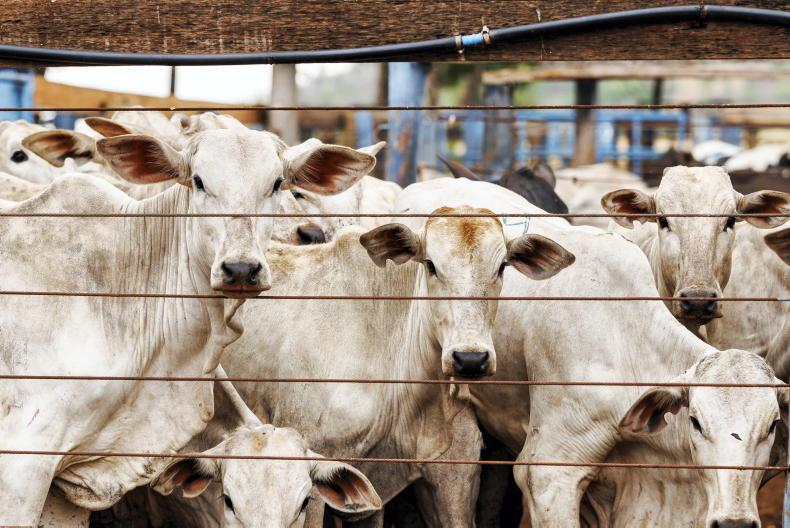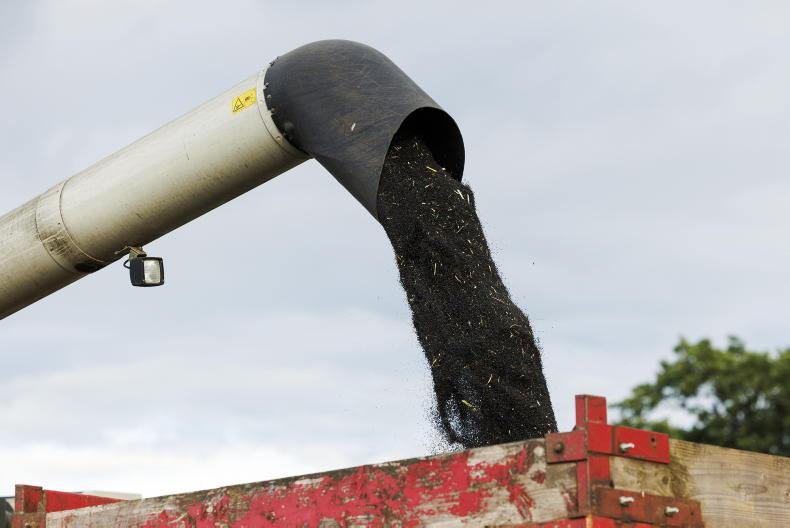Farmers have suffered significantly from highly volatile fertiliser prices over recent years which have massively increased the uncertainty over when they should purchase their annual soil nutrient supplies.
In recent months we have seen a constant rise in the cost of nitrogen, and unfortunately, our analysis suggests that there is little chance that this will reverse in either the short or the medium term (see Figure 1). The factors that have driven the rise in costs, outlined below, seem set to remain in place for to foreseeable future, and in some cases may get considerably worse.
The huge spike in fertiliser prices in the wake of the Russian invasion of Ukraine was mostly driven by the massive jump in the cost of gas. Production of nitrogen is a very energy intensive operation and the surge in those costs in 2022 saw the price of fertiliser in that year rise to a multiple of 2020 and 2021 levels.
The year 2023 saw a normalisation of those gas prices with gas traded in Europe dropping close to €20 per MW (megawatt-hour).
However, the second half of last year saw a reversal of that trend which continued into 2025, with gas currently trading closer to €50 per MW.
The rise has been driven by concerns over the level of stocks in Europe and a cold start to the year which has increased demand.
Across the EU only Latvia, Portugal and Sweden have gas stockpiles higher than the five-year average.
There are concerns over future supplies, with demands from Asia for liquified natural gas (LNG) potentially increasing competition for gas as Europe seeks to replenish stockpiles.
Investment bank Goldman Sachs has a forecast of €50 per MW for 2025, but says higher demand from Asia or a long winter in Europe could drive that to €84 per MW.
There is one wild card in the outlook for energy prices, and that is the potential for the return of Russian gas supplies.
The EU has significantly reduced its reliance on gas from Russia since the invasion of Ukraine, but if a peace deal is reached there could be the potential for the return of those supplies which could move gas prices lower.
Russian supplies
The Russia factor is not only an indirect driver of fertiliser prices through the energy market, it is also a direct driver of fertiliser prices through supplies to the European market. Most recent data shows that despite financial restrictions put on doing business with companies in the country, Russia still supplied 25% of the EU fertiliser imports. Due to the traditional reliance on those supplies the EU did not place additional tariffs on fertiliser from Russia.
However, that is set to change in the coming months with the European Commission proposing the introduction of fresh tariffs on those imports. Currently fertiliser from Russia and Belarus is subject to a tariff of approximately €20 per tonne. Under the Commission proposal that would be increased to €40-€45 per tonne in July of this year, rising to €315 per tonne for nitrogenous fertilisers in three years’ time. This effectively means that the cost of those imports to European farmers will double by 2028.
The European industry has welcomed the proposal, with representative body Fertilizers Europe saying it is a “necessary response to the current geopolitical and economic challenges”. Leo Alders, president of the body said: “For too long, the European fertilizer industry has been exposed to artificially low-priced imports from Russia and Belarus, seriously distorting the market and undermining fair competition.”
Fertilizers Europe also called for the tariffs to be introduced at a level closer to €100 per tonne and that it be reviewed on a semi-annual basis. There was a very different take on the proposal from European farmer representative organisation Copa Cogeca which said that the move will “severely impact agricultural production and competitiveness” adding that “without a clear diversification strategy, European farmers will soon find themselves up against the wall.”
Copa Cogeca also make the point that European production is falling with several fertiliser plants closed recently.
Yara’s facility in Hull has been mothballed, while Germany’s largest maker SKW Piesteritz has cut production and shut down one factory.
Carsten Franzke, managing director at SKW Piesteritz said: ”as a company we are facing a situation in which we absolutely are not competitive”.
He cited the price of energy, but also EU environmental regulations which require fertiliser makers to use 42.5% renewable energy.
If that energy is not available, they are obliged to purchase carbon credits to offset their use of fossil fuels, further adding to production costs.
European production of nitrogenous fertilisers dropped by more than 3m tonnes between 2021 and 2023, falling to its lowest level since at least 2008 (see Figure 2).
Rather worryingly for European supplies the level of fertiliser imports seems to have hit a bit of a speedbump at the start of this year, with imports in January 20% lower than the five-year average.
This suggests that as well as the cost increases, there could be lower supplies of fertilisers available in the market this year (see figure 3).
In its response to the proposed introduction of tariffs on Russian exports, Copa Cogeca also called for elimination of anti-dumping duties on imports of urea, ammonium nitrate and UAN mixtures from the US and Trinidad and Tobago.
Were this to happen, it could open a new source of cheaper imports.
However, the current trade environment, particularly regarding the US does not suggest that anyone is in the mood for removing trade barriers right now.
Environmental requirements
Finally, there is another significant barrier to EU fertiliser imports coming into place in 2026. Payments under the Carbon Border Adjustment Mechanism (CBAM) will have to be made for carbon intensive imports from January 1 2026.
The CBAM system is designed to prevent so-called “carbon leakage” where carbon intensive production happens outside the EU and goods are then imported into the bloc.
The rules are intended to put a fair price on the carbon emitted during the production of the products and to encourage greener production methods outside the EU.
In effect, however, it will act like an import tax as the onus will be on the importer to pay for carbon credits on the EU Emissions Trading System to offset the carbon cost of the off-shore production.
Obviously, the cost to the importer of these carbon credits will go straight on the price of a tonne of fertiliser, adding further costs for the farmer.
Interestingly, the introduction of a similar CBAM measure for the UK does not come into effect until Jan 1, 2027, a year later, suggesting there could be a price differential across the border next year.
As well as CBAM, there is the already mentioned requirement for EU fertiliser makers to source 42.5% of their energy requirements from renewable sources, or buy carbon credits to offset any balance below that.
The combined effects of this rule and CBAM mean that rules aimed at reducing the environmental cost of fertiliser production will inevitably turn into financial costs for farmers who will pay for the price of carbon credits in every tonnes of fertiliser they purchase.
As every farmer knows the price of fertiliser has risen in recent months.
The bad news is that whatever about short-term volatility in those costs, it is increasingly looking like there are structural drivers already in place which mean that fertiliser prices will be higher over the medium to longer term.
The potential for tariffs and certainty about the introduction of carbon taxes mean that imports are almost definitely going to cost more.
The closure of factories in Europe, despite the recent rise in prices, means that the cost of producing fertiliser in Europe is higher than the current market level.
This means that a financially sustainable fertiliser industry in the EU will need higher prices. An environmentally sustainable industry will also mean higher prices.
Whichever way it is sliced, fertiliser prices are going to rise over the medium to longer term.
The one thing which could be a game changer would be the peaceful end to the Russian invasion of Ukraine.
If a peace deal is reached then it may lead to a resumption of gas flows to the EU and a significant drop in industry input costs.
There may even be a rethink on the proposed tariffs on Russian and Belarusian imports.
While the CBAM costs are locked in, a price rise from what would be a lower base would prove more manageable for farmers.
In short
Fertiliser prices are rising. EU production is falling.Energy prices are higher.Proposed tariffs imports from Russia.New environmental costs coming.
Farmers have suffered significantly from highly volatile fertiliser prices over recent years which have massively increased the uncertainty over when they should purchase their annual soil nutrient supplies.
In recent months we have seen a constant rise in the cost of nitrogen, and unfortunately, our analysis suggests that there is little chance that this will reverse in either the short or the medium term (see Figure 1). The factors that have driven the rise in costs, outlined below, seem set to remain in place for to foreseeable future, and in some cases may get considerably worse.
The huge spike in fertiliser prices in the wake of the Russian invasion of Ukraine was mostly driven by the massive jump in the cost of gas. Production of nitrogen is a very energy intensive operation and the surge in those costs in 2022 saw the price of fertiliser in that year rise to a multiple of 2020 and 2021 levels.
The year 2023 saw a normalisation of those gas prices with gas traded in Europe dropping close to €20 per MW (megawatt-hour).
However, the second half of last year saw a reversal of that trend which continued into 2025, with gas currently trading closer to €50 per MW.
The rise has been driven by concerns over the level of stocks in Europe and a cold start to the year which has increased demand.
Across the EU only Latvia, Portugal and Sweden have gas stockpiles higher than the five-year average.
There are concerns over future supplies, with demands from Asia for liquified natural gas (LNG) potentially increasing competition for gas as Europe seeks to replenish stockpiles.
Investment bank Goldman Sachs has a forecast of €50 per MW for 2025, but says higher demand from Asia or a long winter in Europe could drive that to €84 per MW.
There is one wild card in the outlook for energy prices, and that is the potential for the return of Russian gas supplies.
The EU has significantly reduced its reliance on gas from Russia since the invasion of Ukraine, but if a peace deal is reached there could be the potential for the return of those supplies which could move gas prices lower.
Russian supplies
The Russia factor is not only an indirect driver of fertiliser prices through the energy market, it is also a direct driver of fertiliser prices through supplies to the European market. Most recent data shows that despite financial restrictions put on doing business with companies in the country, Russia still supplied 25% of the EU fertiliser imports. Due to the traditional reliance on those supplies the EU did not place additional tariffs on fertiliser from Russia.
However, that is set to change in the coming months with the European Commission proposing the introduction of fresh tariffs on those imports. Currently fertiliser from Russia and Belarus is subject to a tariff of approximately €20 per tonne. Under the Commission proposal that would be increased to €40-€45 per tonne in July of this year, rising to €315 per tonne for nitrogenous fertilisers in three years’ time. This effectively means that the cost of those imports to European farmers will double by 2028.
The European industry has welcomed the proposal, with representative body Fertilizers Europe saying it is a “necessary response to the current geopolitical and economic challenges”. Leo Alders, president of the body said: “For too long, the European fertilizer industry has been exposed to artificially low-priced imports from Russia and Belarus, seriously distorting the market and undermining fair competition.”
Fertilizers Europe also called for the tariffs to be introduced at a level closer to €100 per tonne and that it be reviewed on a semi-annual basis. There was a very different take on the proposal from European farmer representative organisation Copa Cogeca which said that the move will “severely impact agricultural production and competitiveness” adding that “without a clear diversification strategy, European farmers will soon find themselves up against the wall.”
Copa Cogeca also make the point that European production is falling with several fertiliser plants closed recently.
Yara’s facility in Hull has been mothballed, while Germany’s largest maker SKW Piesteritz has cut production and shut down one factory.
Carsten Franzke, managing director at SKW Piesteritz said: ”as a company we are facing a situation in which we absolutely are not competitive”.
He cited the price of energy, but also EU environmental regulations which require fertiliser makers to use 42.5% renewable energy.
If that energy is not available, they are obliged to purchase carbon credits to offset their use of fossil fuels, further adding to production costs.
European production of nitrogenous fertilisers dropped by more than 3m tonnes between 2021 and 2023, falling to its lowest level since at least 2008 (see Figure 2).
Rather worryingly for European supplies the level of fertiliser imports seems to have hit a bit of a speedbump at the start of this year, with imports in January 20% lower than the five-year average.
This suggests that as well as the cost increases, there could be lower supplies of fertilisers available in the market this year (see figure 3).
In its response to the proposed introduction of tariffs on Russian exports, Copa Cogeca also called for elimination of anti-dumping duties on imports of urea, ammonium nitrate and UAN mixtures from the US and Trinidad and Tobago.
Were this to happen, it could open a new source of cheaper imports.
However, the current trade environment, particularly regarding the US does not suggest that anyone is in the mood for removing trade barriers right now.
Environmental requirements
Finally, there is another significant barrier to EU fertiliser imports coming into place in 2026. Payments under the Carbon Border Adjustment Mechanism (CBAM) will have to be made for carbon intensive imports from January 1 2026.
The CBAM system is designed to prevent so-called “carbon leakage” where carbon intensive production happens outside the EU and goods are then imported into the bloc.
The rules are intended to put a fair price on the carbon emitted during the production of the products and to encourage greener production methods outside the EU.
In effect, however, it will act like an import tax as the onus will be on the importer to pay for carbon credits on the EU Emissions Trading System to offset the carbon cost of the off-shore production.
Obviously, the cost to the importer of these carbon credits will go straight on the price of a tonne of fertiliser, adding further costs for the farmer.
Interestingly, the introduction of a similar CBAM measure for the UK does not come into effect until Jan 1, 2027, a year later, suggesting there could be a price differential across the border next year.
As well as CBAM, there is the already mentioned requirement for EU fertiliser makers to source 42.5% of their energy requirements from renewable sources, or buy carbon credits to offset any balance below that.
The combined effects of this rule and CBAM mean that rules aimed at reducing the environmental cost of fertiliser production will inevitably turn into financial costs for farmers who will pay for the price of carbon credits in every tonnes of fertiliser they purchase.
As every farmer knows the price of fertiliser has risen in recent months.
The bad news is that whatever about short-term volatility in those costs, it is increasingly looking like there are structural drivers already in place which mean that fertiliser prices will be higher over the medium to longer term.
The potential for tariffs and certainty about the introduction of carbon taxes mean that imports are almost definitely going to cost more.
The closure of factories in Europe, despite the recent rise in prices, means that the cost of producing fertiliser in Europe is higher than the current market level.
This means that a financially sustainable fertiliser industry in the EU will need higher prices. An environmentally sustainable industry will also mean higher prices.
Whichever way it is sliced, fertiliser prices are going to rise over the medium to longer term.
The one thing which could be a game changer would be the peaceful end to the Russian invasion of Ukraine.
If a peace deal is reached then it may lead to a resumption of gas flows to the EU and a significant drop in industry input costs.
There may even be a rethink on the proposed tariffs on Russian and Belarusian imports.
While the CBAM costs are locked in, a price rise from what would be a lower base would prove more manageable for farmers.
In short
Fertiliser prices are rising. EU production is falling.Energy prices are higher.Proposed tariffs imports from Russia.New environmental costs coming. 









SHARING OPTIONS